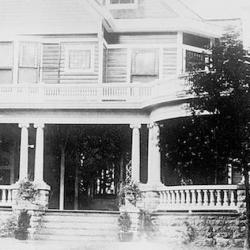Charles Marohn, Jr. (Thoughts on Building Strong Towns, 1) calls suburbanization a “grand experiment” in urban planning and growth. His less neutral description is that it’s a “Ponzi scheme.”
Since World War II, suburbanization has occurred in several phases. First, “transfer payments” from state and federal government funded “local growth initiatives such as new roads, sewers, industrial parks and community facilities.” Then there was spending on transportation, especially the interstate highway system. The third phase was funded by debt, mostly “non-governmental debt including mortgages, commercial real estate loans, credit cards and more” (5).
Each phase has two characteristics: first, a low initial cost for the cities that embark on this experiment and, second, “with each increment of new growth, the city assumes the long-term liability of maintaining all improvements deemed ‘public”” (5).
This can only work if one of two things turns out to be true: the city’s growth – specifically, the increase of tax revenues from the growth catalyzed by the schemes – will “exceed the long-term maintenance and replacement cost of infrastructure the public is now obligated to maintain”; or, the city will continue to grow at an increasing speed “so as to generate the cash flow necessary to cover long-term obligations” (6).
Neither of these turns out to be true. Marohn has collected data from many cities, and “in every instance” finds that “there is a tremendous gap in the long-term finances once the full life-cycle cost of the public obligations are factored in” (7). Unless resources are shifted from “food, energy, transportation, health care, education” to infrastructure, “American cities do not have even a fraction of the money necessary to maintain our basic infrastructure systems” (7).
If that sounds scary, the case studies make it scarier. In one town, a suburban road is resurfaced at the cost of $354,000. Marohn asked how long it would take the city to recoup that money from the taxes paid by property owners. The answer is 79 years. But the road’s life-cycle is only a third of that. By the time this initial repaving is paid off, the road will have to be repaved another 2-3 times. To cover actual costs, property taxes would have to increased by 46% (7-8).
Another example: “A small town received support to build a sewer system from the federal government back in the 1960s as part of a community investment program. Additional support was given in the 1980s to rehabilitate the system. Today, the system needs complete replacement at a cost of $3.3 million. This is roughly $27,000 per family, which is also the city’s median household income. Without massive public subsidy, this city cannot maintain their basic infrastructure. It is, essentially, a ward of the state” (9).
Like any Ponzi scheme, there’s a short-term benefit. Cities grow, take in more revenue, can pay off old obligations. If the city grows and grows at increasing rates, it can continue to cover its costs. When the rate of growth slows, everything goes badly. And the infrastructure that sparked the growth at the outset has a finite life-cycle. It wears out. And cities have enormous obligations they can’t pay.
The fundamental problem, as Marohn sees it, is that “our places do not create wealth, they destroy wealth.” The “American style of building places . . . creates modest short-term benefits and massive long-term costs.” Sixty years into the experiment, long term costs are piling up and few if any cities are able to pay their obligations.
This isn’t a problem just for those cities who took the bait and entered the Ponzi game. It’s a problem for the entire US economy. Sustaining our system requires our capacity to generate excess wealth. The latest round of suburbanization is based on debt; we used debt to pay for maintenance of the first round of infrastructure improvement and debt to build more improvements.
It is, Marohn says, “a disaster of monumental proportions for the United States. Not only have we created an entire economy based on a growth model that can’t be sustained,. in the process we have highly indebted our population. The quality employment opportunities available for the masses rely solely on the perpetuation of this unsustainable model, so we can’t even work our way out of this mess. We’ve tied up our individual wealth into home – homes whose value is tied to community infrastructure that we cannot afford to maintain without hyper-growth, which we are not powerless to induce” (16). The entire US economy is “‘all in’ on the suburban experiment” (17).
And on top of all that, we’ve convinced ourselves that the suburban ideal is the American Dream and the American birthright. We’ve convinced ourselves we have a right to this unsustainable ideal.
What’s the solution? Marohn is blunt: “We cannot sustain the trajectory we are on, but we’ve gone too far down the path to turn back. None of our dominant political ideologies can solve this problem. In fact, there is no solution” (17).
We’re headed to some sort of breaking point, he thinks. He has confidence that Americans have the determination and creativity to weather this storm as we’ve weathered others. But on the other side of the breaking point, we need a different model for growth.
His solution is breathtakingly simple. Once we had sustainable growth because “we built places that financially sustained themselves” (19).
More elaborately, he says that Americans need to devote their energies to “placemaking”: “We need to wring more value out of our places and that is only going to happen if we understand how to create value in the first place.” We need to ask a question “none of our public officials has ever asked,” namely, “will this public project generate enough tax revenue to sustain its maintenance over multiple life cycles?” (19). If yes, build it. If no, don’t.
In another essay in the volume, Marohn suggests that cities should evaluate the productivity (= tax value) not by estimating revenue per lot but by measuring revenue per acre. A new Wal-Mart seems to be a boon to a local economy, a large establishment that will dump taxes into the local coffers. But while “the large business may provide a lot of tax base. . . it also chews up a lot of land and requires a lot of infrastructure” (37-38).
If revenue is measured on a per-acre basis, a collection of smaller businesses on the same land is preferable. A large business that covers five acres brings in $14,000 in tax revenue; but that is only $2860 per acre. A small business on a quarter acre brings in only $1200 per year in tax revenue, but the per-acre yield is $4960. Struggling cities may not need to attract large businesses, but crate an environment where smaller business can be revived and started (38-41).












